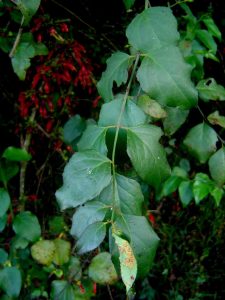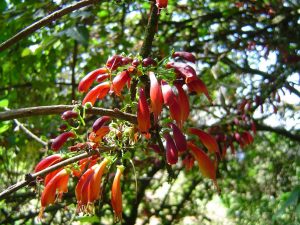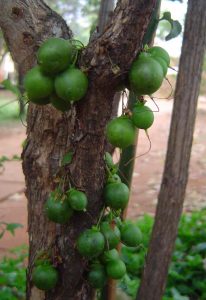HALLERIA LUCIDA
A SUCCESSFUL SMALL TREE FOR South African gardens by Rodney Saunders, Veld and Flora, September 1988, Vol. 74, No. 3
Whenever I am asked to recommend a tree that is evergreen, fast growing, drought resistant, hardy to frost, has sweet smelling flowers and finally, berries that attract birds, I am tempted to suggest privet, for it is the only tree that I know that fits all these specifications. However, there is one indigenous tree, lacking the vulgarity of privet, that approaches the same ease of cultivation, and that is Halleria lucida, a member of the snap dragon family, Scrophulariaceae, commonly known as ‘Notsung’ tree, fuchsia or white olive.
The tree gets its generic name from an eighteenth century European botanist, Allbrecht von Haller, and the specific name ‘lucida’, meaning bright, shiny and clear, refers to the leaves. The flowers resemble those of the cultivated fuchsia and hence the common name, tree fuchsia. The name ‘Notsung’ is believed to be of Hottentot origin, although Marloth states that the name was applied to the tree by early German foresters, and is a corruption of the German word ‘Nutzung’ meaning usufruct, as the wood of Halleria lucida was free and no permit was required to cut it.



Distribution. Halleria lucida is widely distributed throughout Africa, from the Sudan in the north to the Cape Peninsula in the south. Within South Africa it is found in all four provinces in a wide variety of habitats ranging from forests and forest margins, to exposed slopes, grassland and karroid scrub. It is this adaptability that makes it an ideal subject for South African gardens.
Description. Halleria lucida is an evergreen shrub or tree, growing to about 2 or 3 m in height, although it can occasionally reach 12 m. The branches are fairly stiff and erect, although the terminal branchlets may be arching and pendulous, particularly when the tree is grown under fertile conditions with plenty of water. The leaves are opposite and are clear, shiny and bright green. The tubular orange to red flowers, occurring from late autumn to spring, are most attractive, but unfortunately are borne on mature wood, frequently on the main trunk itself, so are generally obscured by the foliage. The flowers are followed by succulent berries which become blackish when ripe. Judging from reports the berries are edible, but not palatable and are said to have a sickly sweet taste which dries the mouth.
Use in the garden. This tree is an ideal screen plant and with its graceful arching habit, forms an excellent backdrop or foil for most garden ornamentals. The roots are not invasive or aggressive, so smaller shade loving plants such as clivia or knowltonia can be cultivated beneath it. It is ideal for small gardens and does well as a specimen plant, on a patio, or as foundation planting around buildings. Preliminary trials have suggested that it may well be suited to container cultivation.
As a means of bringing birds back into the garden, this tree may well be unequalled. The flowers have a plentiful supply of nectar and several species of sunbirds are attracted to the tree throughout the flowering period. The succulent berries ripen from August onwards, at a time when very little else in the garden is in fruit and this attracts the fruit eaters. White eyes can be found in the tree throughout the year, either feeding or seeking shelter. In fact, Halleria lucida forms a bird community centre in the garden and deserves wider recognition amongst gardeners.
Acknowledged with thanks to the author and publisher.
Taken from Tree Life 184 June 1995

